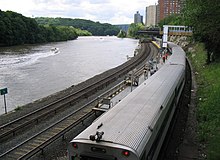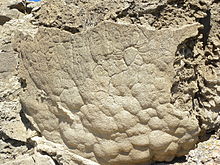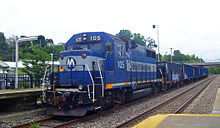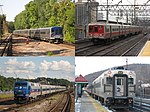Metro-North Railroad: Difference between revisions
→Open House: eliminated reference to "third weekend" in October, as 2008 open house was 2nd weekend |
→Harlem Line: removed footnote, had linked to newspaper website which longer exists |
||
| Line 60: | Line 60: | ||
=====Harlem Line===== |
=====Harlem Line===== |
||
There are plans to redevelop the former [[Harlem Valley State Hospital|Wingdale Psychiatric Center]] into a community of mixed housing and commercial space near the [[Harlem Valley-Wingdale (Metro-North station)|Wingdale-Harlem Valley Station]]. |
There are plans to redevelop the former [[Harlem Valley State Hospital|Wingdale Psychiatric Center]] into a community of mixed housing and commercial space near the [[Harlem Valley-Wingdale (Metro-North station)|Wingdale-Harlem Valley Station]]. |
||
=====New Haven Line===== |
=====New Haven Line===== |
||
Revision as of 20:50, 19 October 2008
| File:MTA Metro-North Railroad logo.png | |
 Metro-North Railroad provides services in the lower Hudson Valley and coastal Connecticut. | |
| Overview | |
|---|---|
| Headquarters | Grand Central Terminal New York, NY |
| Reporting mark | MNCR (Revenue) MNCW (Non-revenue) MN (West-of-Hudson) |
| Locale | Hudson Valley, southwestern Connecticut |
| Dates of operation | 1983–present |
| Technical | |
| Track gauge | 1,435 mm (4 ft 8+1⁄2 in) standard gauge |
The Metro-North Commuter Railroad Company, trading as MTA Metro-North Railroad, or, more commonly, Metro-North, is a suburban commuter rail service that is run and managed by the Metropolitan Transportation Authority (MTA), an authority of New York State. Metro-North runs service between New York City to its northern suburbs in New York and Connecticut, as well as to other regions, including, in conjunction with New Jersey Transit, to parts of New Jersey as well. Trains terminate in places respective to their branch line; these locals include, in New York State, in Port Jervis, Spring Valley, Poughkeepsie, and Wassaic; in Connecticut, in New Canaan, Danbury, Waterbury, and New Haven. Metro-North also provides local rail service within New York City with a reduced fare.
The MTA, which also operates the New York City Transit Authority buses and subways, as well as the Long Island Rail Road, also has jurisdiction, through Metro-North, for use of the railroad lines on the western and eastern portion of the Hudson River in New York State. Service on the western side of the Hudson, within New Jersey, is actually operated by New Jersey Transit under contract with the MTA. North of the New Jersey state line, the western portion of the Hudson is part of New York State, and is also under the jurisdiction of Metro-North. There are 120 stations operated by Metro-North.
Background
Metro-North Headquarters is located at 347 Madison Ave. New York, NY 10017
Before the MTA
Before the Metro-North service was running as it is today, most of the same trackage was under the control of the large New York Central Railroad. Among the multiple rail branches the group eventually controlled was the New York & Harlem Railroad, which is where a fair portion of Metro-North trains serve today.[1] From the mid-1800s until 1969 the New Haven Line, including the New Canaan, Danbury, and Waterbury branches, was owned by New York, New Haven and Hartford Railroad. This branch was started in the 1830s as a system of horse-pulled cars that connected the then-early Lower Manhattan to Harlem. The railroad had blossomed into multiple rail lines by 1852 that provided connecting service to Albany, Boston, Vermont, and even to Canada, through the junction of Chatham[2]. In the 1870s, the New York & Harlem Railroad was bought by Commodore Vanderbilt, which added more railroad lines to his complex empire of railroads, which were run by the New York Central Railroad. However, a century later, around 1968, the northern section of rail in New York state was then owned by Penn Central Transportation because of a merger between the New York Central Railroad and the Pennsylvania Railroad. However, this merger eventually failed, due to large financial costs and government regulations, and the group would eventually be folded into the government created Conrail. The northern branch of railroad which served the Harlem Valley had then been ignored by Conrail, because of outrageous costs of maintaining service. At that point operational service ran only through Millerton, New York, by 1976; in 1980, to Wassaic, and after that, to Dover Plains, where it remained until 2000. However, the MTA had assumed responsibilities of all commuter rail from New York City earlier, in 1972, which has led to some success.
After the MTA
After the state-run MTA had taken control over parts of the former Penn Central in 1972, there was much work needed in reorganization, as significant business success would not appear for at least two decades, following the altogether faltering railroad industry in the 1970s.[2] By 1983, Metro-North, as it is today, was founded, and began to serve various regions in New York State and Connecticut. Today, the service has gained both respect and monetary success, according to the MTA's own website. 2006 was the best year for the line, as there was a 97.8% rate of on-time trains, a record amount of ridership (76.9 million people), and a passenger satisfaction rating of 92%.[2]
Lines


East of Hudson
Three Metro-North lines provide passenger service on the east side of the Hudson River, all of which terminate into Grand Central Terminal in Manhattan: the Hudson Line, Harlem Line and New Haven Line, which is, for the most part, located in Connecticut. An additional line, the Beacon Line, is used for internal equipment moving between the Brewster shop & Danbury station, and does not provide passenger service.
The Hudson and Harlem Lines terminate in Poughkeepsie, New York, and in Wassaic, New York, respectively. No other branches extend from these lines except that Metro-North does provide connecting service at the termination of the Harlem line to the surrounding region during summer months.
The Harlem and Hudson lines, and the Park Avenue mainline to Grand Central, are actually owned by Midtown TDR Ventures LLC, who bought them from the corporate successors to Penn Central[3], but the MTA has a lease on the entire system extending to 2274, and an option to buy starting in 2017.[4]
The New Haven Line is operated through a partnership between Metro North and the State of Connecticut. Under the arrangement, the Connecticut Department of Transportation (ConnDOT) owns the tracks and stations within Connecticut. ConnDOT also finances and performs capital improvements to such, within Connecticut. MTA owns the tracks and stations, and handles capital improvements for such within New York State. MTA also performs routine maintenance and provides police services for the entire New Haven Line, its branches and stations. New cars and locomotives are typically purchased in a joint agreement between MTA and ConnDOT, with the agencies paying for 33.3% and 66.7% of the tab, respectively. ConnDOT pays more because most of the line is located in Connecticut.
The New Haven Line has three branches providing connecting service in Connecticut- the New Canaan Branch, Danbury Branch and Waterbury Branch. Amtrak also operates intercity train service along the New Haven and Hudson Lines. At New Haven, the Shore Line East connecting service, which is run by Connecticut, continues east to New London. The New Haven Line also connects to the Providence and Worcester Railroad spur to the New Haven Shipping Terminal, facilitating the movement of freight to and from the terminal. Freight trains occasionally run on the New Haven Line as CSX, P & W, and Housatonic Railroad each have trackage rights on certain sections.
Because New Haven line is also part of Amtrak's Northeast Corridor, high-speed Acela Express trains run on the line from New Rochelle to New Haven, making stops at Stamford and Union Station in New Haven.
Future plans
Metro-North is continually upgrading trackage and station facilities.[5]
Metro-North is also going to upgrade its Operations Control Center located in Grand Central Terminal. In 2008, construction will start on a new Operations Control Center to replace all control hardware. Software upgrades will provide for state of the-art rail traffic technology.
A major signal study that will help Metro-North design and start construction on a new signal system on all three lines in both New York and Connecticut will continue in 2008. [citation needed]
Hudson Line
Metro-North plans to build a new station to directly serve the new Yankee Stadium, which is scheduled to open in 2009. It has been said that all three lines will be able to access the new station, but Metro-North hasn't said if Harlem and New Haven Line trains will go there directly (by turning at Mott Haven Junction) or if passengers will be required to transfer, likely at Harlem-125 Street, or Grand Central Terminal.
Harlem Line
There are plans to redevelop the former Wingdale Psychiatric Center into a community of mixed housing and commercial space near the Wingdale-Harlem Valley Station.
New Haven Line
Plans are underway to reelectrify the Danbury Branch[6] with a concurrent expansion to New Milford. Work is set to begin in late 2007 on a third Metro-North station for the Town of Fairfield, Connecticut. This station, to be located in eastern Fairfield near the Bridgeport line, will be part of a large mixed-use development known as Fairfield Metro Center, though the station is likely to be named Black Rock or Black Rock Turnpike.[citation needed] Connecticut officials and Metro North are conducting environmental studies for a new station in West Haven. ConnDOT is also moving forward on a study to increase freight service on the New Haven Line in an effort to reduce the number of trucks on the congested Connecticut Turnpike. A number of projects are either planned or underway that will upgrade the catenary system, replace outdated bridges, and straighten certain sections of the New Haven Line to accommodate the Acela's 240 km/h (150 mph) maximum operating speeds. [citation needed]
Hartford-Springfield Line (Proposed plan)
The Massachusetts Executive Office of Transportation (MEOT) and ConnDOT are preparing an environmental impact statement for establishing passenger rail service from Union Station in New Haven to Springfield, Massachusetts via Hartford, Connecticut, including either a spur line or light rail connection to Bradley International Airport. The proposed line will use existing freight lines owned by Amtrak and CSX. MEOT and ConnDOT have listed Metro-North and Amtrak as potential operators of the future Springfield Line.[7]
Expansion
There has occasionally been talk of expanding all three lines northward.[citation needed] Northward expansion of the Hudson Line has often met opposition from residents of communities including Hyde Park and Rhinecliff, even though the latter is home to Amtrak's Rhinecliff-Kingston station, frequented by commuters who live in northern Dutchess and Ulster Counties.[8]
West of Hudson
Metro-North also provides service on trains west of the Hudson River that originate from Hoboken Terminal, New Jersey. This service is jointly run by both New Jersey Transit, and by Metro-North, under contract. There are two branches of the west-of-Hudson service, the Port Jervis Line, and the Pascack Valley Line, according to a Metro-North map. The Port Jervis Line is accessed from two New Jersey Transit Lines, the Main Line and the Bergen County Line.
The Port Jervis Line terminates in Port Jervis, New York, and the Pascack Valley line in Spring Valley, New York; these lines are located in Orange and Rockland Counties, respectively. Trackage on the Port Jervis Line north of the Suffern Yard is leased from Norfolk Southern by the MTA. New Jersey Transit, however, owns all of the trackage that is part of the Pascack Valley line in Rockland County, New York. Both lines, were once part of the Erie Railroad.
Because the vast majority of the stops for the Port Jervis Line and the Pascack Valley Line are located in New Jersey, New Jersey Transit provides much of the rolling stock (the cars for the trains) and the staffing, to operate the service west of the Hudson river. However, Metro-North equipment has been used on other lines that are operated by New Jersey Transit on the Hoboken division.
All stations west of the Hudson River in New York, except for Template:Njt-sta, are owned and operated by Metro-North.
Future plans
The MTA is working with the Tappan Zee Bridge Environmental Review on several options where a future replacement for the Tappan Zee Bridge would include a rail line to connect the Port Jervis Line in Rockland County to the Hudson Line in Westchester County. "Alternatives 4A, 4B and 4C" all include plans for such a rail line to connect with the Hudson Line at Tarrytown, providing a one-seat ride from Rockland County to Grand Central Terminal in New York City. All three also include mass-transit service across Westchester County, connecting to the Harlem Line in White Plains, and the New Haven Line at Port Chester. The only difference between the three is whether the cross-Westchester trip will be accomplished by heavy rail, light rail or rapid bus service. [9]
Metro-North is also considering extending Port Jervis Line service to Stewart International Airport in Newburgh [10], a move that could make a Tappan Zee Bridge rail line even more useful, as it would serve both commuters and travelers who choose to fly to and from Stewart, instead of the other three New York City-area airports.
Technical details

East of Hudson
Some services are operated by diesel, but most services running directly into Manhattan Grand Central Terminal are electric powered using the older M1, M2, M3, M4, M6 and brand new M7 MU cars. The exception are 4 peak-hour trains from Wassaic and all through trains from Poughkeepsie. In the case when the diesel powered train runs into Grand Central, the switch over from diesel to third-rail operation is made somewhere around the Harlem-125 Street station. Most of Metro-North's passenger diesel locomotives are General Electric GENESIS P32 diesel-electric hybrids capable of switching to a pure electric mode using contact shoes to contact the railroad's under-running third rail power distribution system. On the Hudson Line, trains are powered by electrified third rail from Grand Central Terminal to Croton-Harmon and are powered by diesel north of that station to Poughkeepsie. The Harlem Line has third rail from Grand Central Terminal to Southeast and are powered by diesel north of that station to Wassaic. The New Haven Line is special in that electrical Multiple Unit (EMU) trains are powered through either 700 V DC from a third rail or 13.8 kV AC from an overhead catenary wire. Nominally 13.8 kV (per a MN Power Director), the voltage floats between 13.2 to 13.8 kV. The main line from approximately Woodlawn to Pelham (3 miles, or 4.8 km), is powered by third rail, while from Pelham, New York east to New Haven, Connecticut (58 miles, or 93 km), as well as the entire New Canaan Branch, is powered by catenary. The Danbury Branch was formerly electrified but in 1961 became a diesel-only line. Locomotives on the Waterbury Branch, the only east-of-Hudson Metro North service which has no direct service of any sort into Grand Central, are powered by diesel.
As of February 2007, some services are still operated by FL9 and F10 diesels built between 1946 and 1960. Also the railroad has a fleet of leased Amtrak Genesis diesels that operate only in non-electrified territory as they are not equipped for dual-mode third rail service. [citation needed]

The third rails on the three Metro-North lines (East-of-Hudson) which go into Grand Central Terminal are unusual in that power is collected from below the third rail as opposed to above, unlike most other third rail systems (including the Long Island Rail Road and New York City Subway). This allows the third rail to be completely insulated from above, thus decreasing the chances of a person being electrocuted by coming in contact with the rail. This was important, because until the early 1970s the majority of the suburban stations had low platforms where the third rail was easily accessible; this danger was greatly reduced with the introduction of the high-level platforming of Budd Company-made Metropolitans (M1A's) in 1971 and the Cosmopolitans (M2's) between 1972 and 1977, both purchased by the MTA and practically identical to their sister cars on the Long Island Rail Road.


West of Hudson
Most of the rolling stock on west-of-Hudson Metro-North lines consists of Metro-North owned and marked Comet V cars, although occasionally other NJT cars are used, as the two railroads pool equipment. The trains are also usually handled by EMD GP40FH-2, F40PH-2CAT or Alstom PL42AC diesel locomotives, although any Metro-North or New Jersey Transit diesel can show up.
Reporting Marks
Although Metro-North uses many official abbreviations (MNCR, MNR, MN, etc.) there are two official AAR reporting marks used on equipment. For non-revenue equipment, the mark registered and recognized on AEI scanner tags is 'MNCW', with revenue equipment is identified using 'MNCR'.
Rolling Stock
All Lines East of Hudson
For non-electrified territory Metro North uses Shoreliners in push pull service with diesel locomotives.
New Haven Line
M2, M4, and M6 are used. These are EMUs which are compatible with both overhead and third rail. The M2 are over 30 years old and will soon be replaced by the new M8s
Harlem Line and Hudson Lines
M3 and the new M7s are used
Fare policies

Metro-North offers many different ticket types and prices depending on the frequency of travel and distance of the ride. While the fare policies of the "East of Hudson" and "West of Hudson" divisions are essentially the same, they operate differently because the West of Hudson trains are operated by New Jersey Transit therefore using their ticketing system. All policies and prices indicated are as of March 1, 2008.
East of Hudson
Tickets may be bought from a ticket office at stations, ticket vending machines (TVMs), online through the "WebTicket" program, or on the train itself. Monthly tickets may also be bought through the MTA's "Mail&Ride" program where monthly passes that are paid in advance, usually by credit card, are delivered by mail to the rider. There is a 5% discount for buying tickets online and a 2-5% discount through Mail&Ride. A surcharge of US$4.75 to $5.50 is added on top of the standard price if a ticket is purchased on a train, unless the station where the rider embarked does not have a ticket machine; in this case the surcharge is waived.
Ticket types available include One-Way, Round-trip (two one-way tickets), 10-trip, Weekly (unlimited travel for one calendar week), Monthly (unlimited travel for one calendar month), and special student and disabled fare tickets. MetroCards are also available on the reverse side of the weekly, monthly, and round-trip tickets.
All tickets to/from Manhattan (Grand Central and Harlem-125th Street) are distinguished as being peak or off-peak. Peak fares, which are substantially higher than off-peak trains, apply to trains that arrive in Grand Central between 5 AM and 10 AM and trains that leave Grand Central between 5:30 AM and 9 AM and from 4 PM to 8 PM all coinciding with the standard New York City rush hours. Off-peak fares are charged all other times including weekends and holidays. Tickets for travel outside of Manhattan are called "intermediate" tickets and the peak/off-peak rules do not apply. Generally, off-peak tickets are 15% less than the peak hour fare.
The fares themselves are distinguished by the 14 zones that the lines are divided into within New York State. In Connecticut, the fare structure is more complex due to the many branches on the New Haven line. Generally, these zones correspond to express stops on the lines and from "blocks" of service within the schedules.
A slight oddity of the fare policy is the CityTicket which can be used between Grand Central and any of the stations within The Bronx during weekends. The current fare is $3.25 despite the Lexington Avenue subway lines (4, 5, 6) serving the same area for only $2.
West of Hudson
The fare structure, for west-of-Hudson trains, resembles the New Jersey Transit fare structure, and less like that of east-of-Hudson trains, despite the fact that both lines has prices dictated by the MTA. On the Pascack Valley and Port Jervis lines, the on-board surcharge is $5.00 at stations with functioning ticket vending machines or ticket offices, which is substantially less than a possible price of $24.00 for a peak-hour Metro-North train on the Harlem line.
Open House

Every October, Metro-North hosts an open house at its Harmon Yard. Buses shuttle visitors from Croton-Harmon to the large brick shop building, where current and former locomotives and rolling stock are on display. Railroad employees from all departments are available to answer questions, share experiences and show how various maintenance equipment works. Food, model train displays and children-oriented activities such as clowns and facepainting are also available. It is popular with families and railfans alike. [citation needed].
In popular culture
The railroad has been featured in several films, most notably in a scene in the film U.S. Marshals, when (Wesley Snipes) jumps from the roof of a multi-story building onto a train; in Steven Spielberg's War of the Worlds, when a train (GE Genesis) that has just been attacked by aliens, speeds out of control and on fire through a railroad crossing; and in The Ice Storm, with M-2 cars on the New Canaan branch that are marked as "Penn Central". The trains are also mentioned in the movie Madagascar as the rail service that “Marty the Zebra” wanted to use to get to Connecticut. Metro-North trains were also the setting for the 1984 film Falling in Love staring Robert De Niro and Meryl Streep. [citation needed] The film Eternal Sunshine of the Spotless Mind was filmed on Metro-North but was meant to take place on the Long Island Rail Road.
An episode of The Twilight Zone, "A Stop at Willoughby" was set largely around a commuter's regular trips on the New Haven line. The main character's stop at Westport was the same as series creator Rod Serling.
A recent Tuscan Dairy Farms commercial featured the northbound platform at Crestwood on the Harlem Line. [11]
References
- ^ MTA Metro-North Railroad
- ^ a b c Railhistory
- ^ Notice Of Exemption: 12/07/2006 - FD_34953_0
- ^ Air Rights Make Deals Fly - New York Post
- ^ "MTA Service Updates".
- ^ "Danbury Branch Electrification Feasibility Study". Retrieved 2007-01-06.
- ^ "New Haven - Hartford - Springfield Commuter Rail Implementation Plan" (PDF). Retrieved 2007-09-11.
- ^ C. J. Chivers (1999-10-12). "Hudson Towns Wary of Rail's Reach; Commuter Line Extension Faces Hostility in Bucolic North Dutchess". The New York Times. Retrieved 2007-10-17.
- ^ Tappan Zee Bridge Environmental Review
- ^ Trans-Hudson study
- ^ Tuscan Dairy Farms Commercial
External links
- Metro-North map
- MTA Metro-North Railroad
- New Jersey Transit (West of Hudson lines ONLY)
- Connecticut Rail Commuter Council, "a consumer liaison between riders and the Connecticut Dept. of Transportation (CDOT), Metro-North, and Shore Line East railroads"
- The history of The New York Central Railroad in the Region
See also
- Articles needing cleanup from May 2008
- Cleanup tagged articles without a reason field from May 2008
- Wikipedia pages needing cleanup from May 2008
- Rail transportation in the New York metropolitan area
- Metro-North Railroad
- Metropolitan Transportation Authority of New York
- United States regional rail systems
- Electric railways in the United States
- Connecticut railroads
- New Jersey railroads
- New York railroads
- Passenger rail transport in Connecticut
- Passenger rail transport in New Jersey
- Passenger rail transport in New York
- Passenger rail transport in New York City
- Government agencies established in 1983




